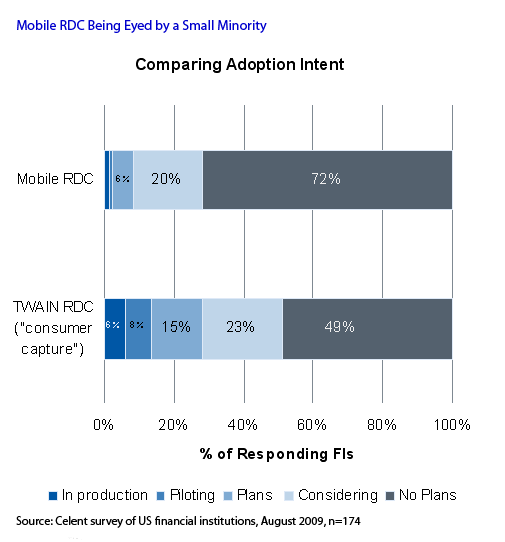Mobile RDC: Self-Service for the Masses?
Abstract
Remote deposit capture (RDC) has thus far been a treasury management product offered by financial institutions in exchange for fee revenue. But have mounting cost pressures and improvements in RDC technology opened the door for the use of RDC as a self-service deposit channel?
Until recently, remote deposit capture has been limited to business clients. The past year has seen over 100 financial institutions offer RDC to consumers using devices they already have (also known as consumer capture), thus eliminating the cost of providing and supporting scanners. Without the cost of providing scanners, RDC becomes a viable self-service deposit channel -- for those with a home scanner. However, most US households do not have a home scanner. What then? Mobile RDC invites the use of camera-equipped cell phones for check image capture as a stand-alone application or as part of a broader mobile banking solution. Sales of camera-equipped smartphones are booming with no end in sight.
Respondents to a Celent survey of financial institutions this past August are planning to offer mobile RDC to both consumers and business customers, according to a new report, Mobile RDC: Self-Service Deposits for the Masses? Only a small minority of US financial institutions currently plan to offer mobile RDC, but that could change as banks face a challenging revenue outlook and mounting cost pressures in the retail channel. "The real challenge with self-service deposits may not be in the product delivery itself as much as the resulting branch transformation that will be required as transactional activities move out of the branch," says Bob Meara, senior analyst with Celent's Banking Group and author of the report.
"The real challenge with self-service deposits may not be in the product delivery itself as much as the resulting branch transformation that will be required as transactional activities move out of the branch," says Bob Meara, senior analyst with Celent's Banking Group and author of the report.
"Self-service deposits stand at odds with the pervasive cross-sell culture most banks perpetuate. Reduced branch traffic at the hands of mobile RDC presents a sales challenge to many retail banks, but deposit-related foot traffic comes at a significant cost -- one that US banks may no longer be able to afford. Mobile RDC may be the best idea yet to hasten the branch transformation we all know to be inevitable," he adds.
Leveraging self-service channels to lower the cost to serve is not a new idea, but doing so in the realm of check deposits is. With consumer capture and mobile RDC, financial institutions have a viable means to dramatically reduce expensive transactional activity in their branch networks. In addition to an analysis of financial institution adoption motives and barriers, this report provides an overview of mobile RDC technology, the current solution provider landscape and a detailed case study of the industry’s first broad based mobile RDC deployment at USAA Federal Savings Bank.

